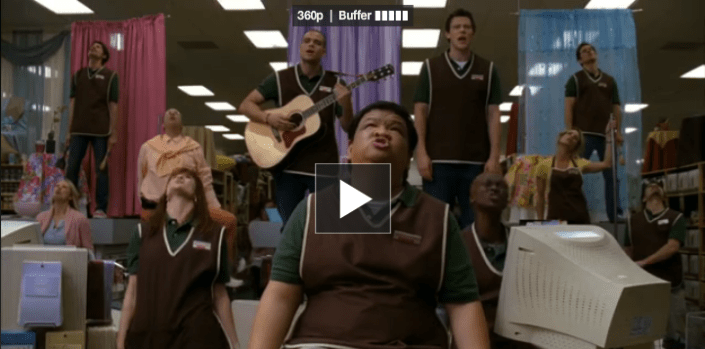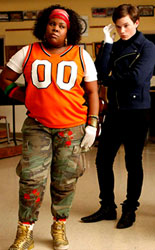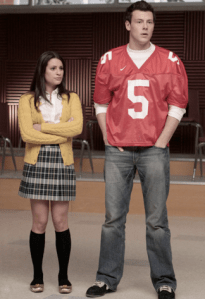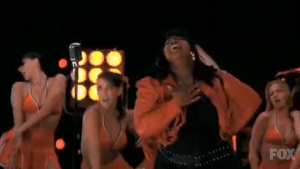Dianna Agron
Glee: The Good, The Bad and The Funky

When I was first introduced to Glee last spring, it was love at first sight. The premiere did all the right things: it was funny, irreverent, quirky and, most importantly, featured an ass-kicking rendition of Journey’s “Don’t Stop Believin’.” Then I had an entire summer to nurture my Glee crush (absence does make the heart grow fonder). But when Glee returned in the Fall of 2009, still basking in the glow of that near perfect premiere, I started to notice some flaws: why did the show’s promotional materials hail its diverse cast—including an African-American, an Asian, a homosexual and a paraplegic—yet sideline them within the show’s diegesis? Why were performance numbers so overproduced and unnatural? And why did character motivations seem to turn on a dime, depending on the whims of the narrative? Yes, Glee seemed perfect during our first date, but after a few episodes I began noticing its beer gut and its toupee. And wait, did Glee just tell me a racist joke? Uh oh…

Like any bad boyfriend, Glee infuriates and then woos me back again, never allowing me to make a clean break and end the relationship. I find the show to be shrill and simplistic one moment and heartfelt and complex the next. And it’s pretty tough to find any television show that features musical performances (something I love in any medium).
After reading the weekly Glee columns featured on Antenna (a media and cultural studies blog operated and edited by graduate students and faculty in the Media and Cultural Studies area of the Department of Communication Arts at the University of Wisconsin – Madison) I was pleased to see that many other ardent “Gleeks” were also uncomfortable with the show’s mixture of intoxicating musical numbers and casual racism/sexism/anti-Semitism. This week I’ve added my own two cents to the “Glee Club.” If you’d like to read my column on this week’s episode, “Funk,” and join in the discussion, you can go ahead and click here.

And I promise to get back to writing for this blog soon as long as you promise to watch my baby for me. You will? Great!
Is GLEE Racist/Heterosexist/Ableist?
Only three episodes have aired but I am already a huge fan of Glee. Hell, I was a huge fan 5 minutes into its premiere last spring. My enthusiasm for the program largely stems from my love of the American film musical: Glee is peppered with elaborate, often integrated, musical numbers. Even the show’s nondiegetic music is sung a capella. Sure, the musical television show has tried and failed to gain traction with American audiences, but Glee seems like it’s going to make it.

In the months following Glee‘s sneak preview/premiere back in May, however, some quiet rumblings began (also here and here). The show includes an African American female character, Mercedes (Amber Riley) who is … wait for it … overweight and sassy. The show also includes a homosexual character, Kurt (Chris Colfer), who loves Liza Minelli and obsesses over his fashion choices and a wheel-chair bound character, Artie (Kevin McHale) with thick, horn-rimmed glasses and sweater vests. Yes, these are a lot of stereotypes.

Of course, stereotypes are not inherently problematic, particularly when a show seems to revel in its stereotypes. For example, Glee is filled with numerous high school movie clichés, including snotty, blonde cheerleaders (Dianna Agron) and a squat, laconic football coach (Patrick Gallagher). But, the early complaints about Glee have been that its African American, Asian, homosexual, and handicapped characters have taken a backseat to the show’s white, heterosexual, able-bodied characters. Rachel (Lea Michele) and Finn (Cory Monteith) have received far more screen time, characterization and most importantly, solos, than any of the other young characters. For example, in the premiere episode’s “big number,” Journey’s “Don’t Stop Believin'”, it is Rachel and Finn who not only monopolize the juiciest bits of the performance, but also turn the song into a romantic duet. I’m not sure that Artie, the parapalegic or Tina (Jenna Ushkowitz), the Asian American character, have had more than 2 lines between them yet. And yet, these characters all over Glee‘s promotional images and in its trailers. As the blogger at Alas! A Blog put it “Diversity consists of real parts, not just tokenism.”
By including (and promoting) a diverse range of characters and then not utilizing them within the narrative or the musical numbers, the show seems to be saying that tokenism is enough. It’s a simulacrum of diversity. An all white cast would not be more politically savory but it would be more honest.

However, there are indications that the show will start allotting more screen time to some of its other perfomers. In the most recent episode, “Acafellas,” the primary narrative revolved around Will’s (Matthew Morrison) attempt to reclaim some of his lost confidence by starting up an all male a cappella quartet that performs 1990s era hip hop. This naturally leads to an a capella rendition of Color Me Badd’s “I Wanna Sex You Up.” Naturally.

But the show’s secondary storyline finally yielded some screen time to Mercedes and her somewhat inappropriate crush on Kurt. Kurt’s rejection provides the segue for one of the episode’s main musical performances, a sultry, dare I say “window busting,” rendition of Jazmine Sullivan’s “Bust Your Windows.” I was happy to see Mercedes have her moment in the spotlight because Amber Riley can really sing. And she looked pretty fierce in her black jumpsuit and fringed red jacket (even if such clothing is completely inappropriate for washing cars). The episode also featured a tender moment when Kurt finally vocalizes, for the first time, that he is gay. Glee often operates at one move away from reality, but this scene was both grounded and touching.

This most recent episode seems to indicate that the show will shift its storylines (and its solos) to different characters from time to time. I hope this is the case because, as I mentioned, I really like musicals. And a capella versions of “Poison.”
But what do you think? Is Glee going to be the kind of program that pays diversity a lot of lip service without actually putting it into practice? Or do we need to give this show more time to grow?